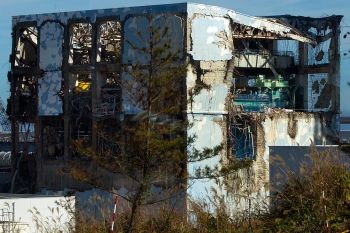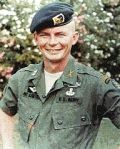
Publisher:
Bonnie King
CONTACT:
Newsroom@Salem-news.com
Advertising:
Adsales@Salem-news.com

~Truth~
~Justice~
~Peace~
TJP
Nov-13-2011 18:30

 TweetFollow @OregonNews
TweetFollow @OregonNews
Confronting Fukushima's Nuclear Contamination 'Dead Zone' in Media Images
Submitted by John McCarthy Salem-News.comThe images from those who have ventured into the contaminated areas offer a shocking look at what has become of this once-vibrant city
 The Unit 4 reactor building of the crippled Fukushima Dai-ichi nuclear power station in Okuma, Japan. (David Guttenfelder, Pool) |
(LOS ANGELES) - Just imagine the Road from Dover, Delaware to Philadelphia, or on to New York - being in a "dead" zone. That is the story in Fukushima prefecture in Japan.
Reminiscent of picture of Chernobyl, Ukraine after that nuclear disaster, the whole picture makes one question how or shy the government of Japan would fail to evacuate families from areas just out of this closed off area of contamination.
The images are laid out with captions and credits, they are a shocking look at what has become of this once-vibrant city where people and business thrived in what they believed to be a safe community.
In the first image, an official from the Tokyo Electric Power Co. (TEPCO), wearing a protective suit and mask, uses a plastic covered megaphone to speak to fellow TEPCO workers and journalists as they drive towards the crippled Fukushima Dai-ichi nuclear power station in Okuma, Japan, Saturday, Nov. 12, 2011.
Conditions at Japan's wrecked Fukushima nuclear power plant, devastated by a tsunami in March, were slowly improving to the point where a "cold shutdown" would be possible as planned, officials said on Saturday during a tour of the facility.
Fukushima Daiichi Nuclear Power Station
12 November 2011
![[Image]](http://cryptome.org/eyeball/daiichi-111211/pict26.jpg)
The nuclear reactor buildings were still surrounded by crumpled trucks, twisted metal fences, and large, dented water tanks. Smaller office buildings around the reactors were left as they were abandoned on March 11, when the tsunami hit.
![[Image]](http://cryptome.org/eyeball/daiichi-111211/pict25.jpg)
Japanese police man a checkpoint near the edge of the contaminated exclusion zone around the crippled Fukushima Dai-ichi nuclear power station near Okuma, Fukushima prefecture, Japan Saturday, Nov. 12, 2011. (David Guttenfelder, Pool)
![[Image]](http://cryptome.org/eyeball/daiichi-111211/pict13.jpg)
A deserted street inside the contaminated exclusion zone around the crippled Fukushima Daiichi nuclear power plant is seen from bus windows in Fukushima prefecture, November 12, 2011.
![[Image]](http://cryptome.org/eyeball/daiichi-111211/pict22.jpg)
A deserted field and buildings inside the contaminated exclusion zone around the crippled Fukushima Dai-ichi nuclear power station are seen through a bus window near Okuma, Japan Saturday, Nov. 12, 2011. (David Guttenfelder, Pool)
![[Image]](http://cryptome.org/eyeball/daiichi-111211/pict23.jpg)
An official from the Tokyo Electric Power Co., right, and an unidentified man, both wearing protective suits and masks ride on a bus as they pass by the crippled Fukushima Dai-ichi nuclear power station, seen through the window, in Okuma, Japan, Saturday, Nov. 12, 2011. (David Guttenfelder, Pool)
![[Image]](http://cryptome.org/eyeball/daiichi-111211/pict20.jpg)
Officials from the Tokyo Electric Power Co. and Japanese journalists look at the crippled Fukushima Dai-ichi nuclear power station from bus windows in Okuma, Japan Saturday, Nov. 12, 2011. Media allowed into Japan's tsunami-damaged nuclear power plant for the first time Saturday saw a striking scene of devastation: twisted and overturned vehicles, crumbling reactor buildings and piles of rubble virtually untouched since the wave struck more than eight months ago. (David Guttenfelder, Pool
![[Image]](http://cryptome.org/eyeball/daiichi-111211/pict19.jpg)
A view of Tokyo Electric Power Co's tsunami-crippled Fukushima Daiichi nuclear power plant in Fukushima prefecture November 12, 2011. (David Guttenfelder, Pool)
![[Image]](http://cryptome.org/eyeball/daiichi-111211/pict2.jpg)
The crippled Fukushima Daiichi nuclear power plant's No.4, No.3, No.2 and No.1 (R-L) reactor buildings are seen from bus windows in Fukushima prefecture November 12, 2011. Reuters
![[Image]](http://cryptome.org/eyeball/daiichi-111211/pict3.jpg)
The crippled Fukushima Daiichi nuclear power plant is seen from bus windows in Fukushima prefecture, November 12, 2011. Reuters
![[Image]](http://cryptome.org/eyeball/daiichi-111211/pict21.jpg)
The Unit 4 reactor building of the crippled Fukushima Dai-ichi nuclear power station is seen through a bus window in Okuma, Japan Saturday, Nov. 12, 2011. Media allowed into Japan's tsunami-damaged nuclear power plant for the first time Saturday saw a striking scene of devastation: twisted and overturned vehicles, crumbling reactor buildings and piles of rubble virtually untouched since the wave struck more than eight months ago. (David Guttenfelder, Pool)
![[Image]](http://cryptome.org/eyeball/daiichi-111211/pict32.jpg)
The Unit 4 reactor building of the crippled Fukushima Dai-ichi nuclear power station is seen through a bus window in Okuma, Japan Saturday, Nov. 12, 2011. (David Guttenfelder, Pool)
![[Image]](http://cryptome.org/eyeball/daiichi-111211/pict27.jpg)
Broken vehicles are abandoned outside Unit 4 turbine building at the crippled Fukushima Dai-ichi nuclear power station as they are observed from inside a bus in Okuma, Fukushima Prefecture, Japan, Saturday, Nov. 12, 2011.
![[Image]](http://cryptome.org/eyeball/daiichi-111211/pict0.jpg)
The crippled Fukushima Daiichi nuclear power plant's upper part of the No.3 reactor building is seen from a bus window in Fukushima prefecture, November 12, 2011. Reuters
![[Image]](http://cryptome.org/eyeball/daiichi-111211/pict29.jpg)
The crippled Fukushima Dai-ichi nuclear power station is seen through a bus window in Okuma, Japan Saturday, Nov. 12, 2011. Media allowed into Japan's tsunami-damaged nuclear power plant for the first time Saturday saw a striking scene of devastation: twisted and overturned vehicles, crumbling reactor buildings and piles of rubble virtually untouched since the wave struck more than eight months ago. (David Guttenfelder, Pool)
![[Image]](http://cryptome.org/eyeball/daiichi-111211/pict4.jpg)
The crippled Fukushima Daiichi nuclear power plant is seen from bus windows in Fukushima prefecture, November 12, 2011. Reuters
![[Image]](http://cryptome.org/eyeball/daiichi-111211/pict16.jpg)
The crippled Fukushima Daiichi nuclear power plant is seen from bus windows in Fukushima prefecture, November 12, 2011. Reuters
![[Image]](http://cryptome.org/eyeball/daiichi-111211/pict24.jpg)
Crushed piping is observed from inside a bus at the crippled Fukushima Dai-ichi nuclear power station in Okuma, Fukushima Prefecture, Japan, Saturday, Nov. 12, 2011. Media allowed into Japan's tsunami-damaged nuclear power plant for the first time Saturday saw a striking scene of devastation: twisted and overturned trucks, crumbling reactor buildings and piles of rubble virtually untouched since the wave struck more than eight months ago. (Ikuro Aiba, Pool)
![[Image]](http://cryptome.org/eyeball/daiichi-111211/pict31.jpg)
Units five and six of the Fukushima Dai-ichi nuclear power station are seen through a bus window in Futaba, Japan Saturday, Nov. 12, 2011. (David Guttenfelder, Pool)
![[Image]](http://cryptome.org/eyeball/daiichi-111211/pict28.jpg)
Members of the media, wearing protective suits, interview Japan's Minister of the Environment, Goshi Hosono, and Chief of the Fukushima Dai-ichi nuclear power plant, Masao Yoshida, inside the emergency operation center at the crippled nuclear power station in Okuma, Japan Saturday, Nov. 12, 2011. (David Guttenfelder, Pool)
![[Image]](http://cryptome.org/eyeball/daiichi-111211/pict33.jpg)
Tokyo Electric Power Co. employees work inside the emergency operation center at the crippled Fukushima Dai-ichi nuclear power station in Okuma, Japan Saturday, Nov. 12, 2011. (David Guttenfelder, Pool)
 While some would challenge hero status for a man who admittedly was ordered to train assassination teams for the CIA during the Vietnam War (none of which carried out a mission), no one can challenge the fact that as a triple volunteer (airborne, ranger, Special Forces), John served his country with bravery, honor and distinction. Like so many of the young men who went to Vietnam, he believed in his country and what he had been taught was the rightness of its mission in the world. But this is also the story of John's disillusionment and of his painful awakening, which came at the cost of wife, family and friends. It is a story about how he stood alone, at a crucial moment, as his country broke its word to him and refused to capitulate as he saw that the moral leadership of those who gave him orders was an empty house of cards. ---
While some would challenge hero status for a man who admittedly was ordered to train assassination teams for the CIA during the Vietnam War (none of which carried out a mission), no one can challenge the fact that as a triple volunteer (airborne, ranger, Special Forces), John served his country with bravery, honor and distinction. Like so many of the young men who went to Vietnam, he believed in his country and what he had been taught was the rightness of its mission in the world. But this is also the story of John's disillusionment and of his painful awakening, which came at the cost of wife, family and friends. It is a story about how he stood alone, at a crucial moment, as his country broke its word to him and refused to capitulate as he saw that the moral leadership of those who gave him orders was an empty house of cards. ---
Mike Ruppert, 7/14/98
For more insight into government from a Vietnam War veteran, see John McCarthy’s website: johnmccarthy90066.tripod.com/id70.html.
 |
 |
 |
 End Israel's Unwarranted Murder of Kids |
Articles for November 12, 2011 | Articles for November 13, 2011 | Articles for November 14, 2011

Quick Links
DINING
Willamette UniversityGoudy Commons Cafe
Dine on the Queen
Willamette Queen Sternwheeler
MUST SEE SALEM
Oregon Capitol ToursCapitol History Gateway
Willamette River Ride
Willamette Queen Sternwheeler
Historic Home Tours:
Deepwood Museum
The Bush House
Gaiety Hollow Garden
AUCTIONS - APPRAISALS
Auction Masters & AppraisalsCONSTRUCTION SERVICES
Roofing and ContractingSheridan, Ore.
ONLINE SHOPPING
Special Occasion DressesAdvertise with Salem-News
Contact:AdSales@Salem-News.com

Salem-News.com:
googlec507860f6901db00.html

Terms of Service | Privacy Policy
All comments and messages are approved by people and self promotional links or unacceptable comments are denied.
[Return to Top]
©2025 Salem-News.com. All opinions expressed in this article are those of the author and do not necessarily reflect those of Salem-News.com.